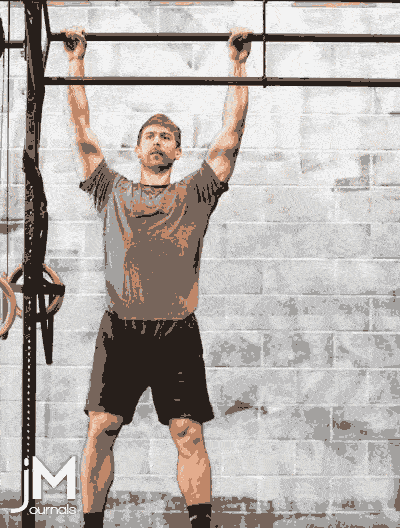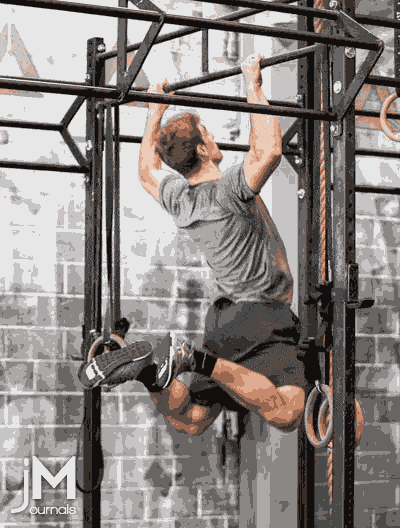The Dead Hang Pull-up
The pull-up is a movement which is focused on moving the body from a hanging position when you are gripping a bar or edge to a chin above the bar position. In order to do a pull-up, you have to create momentum and force on the bar or edge that you’re trying to lift yourself above.
It is pretty functional because there are many times when being able to pull yourself above a ledge or above a surface comes in handy, especially if you are used to putting yourself in life-threatening positions.
The other nice benefit of a solid pull-up is that when done correctly it is a full upper body movement and when using a kip it can become a hip thrusting movement as well.
The pull-up can be a very difficult and frustrating movement depending on your starting strength but it is also a movement which can be worked on, and once achieved, is a highlight of physical fitness.
Scaling: Finding the right assist
There are many ways to scale the pull up so that you can increase your fitness level at a level that is appropriate to your strength. For instance, you can use bands of varying tightness to leverage yourself above a bar because they will aid your ability to get over the bar. You can also place a box underneath your feet so that you are kneeling to start the pull-up, allowing you to use your legs to assist in the pull-up. Another way to scale is to perform jumping pull-ups where you stand below the bar and jump up to it, using your momentum to get over your chin over. Although this is not recommended, you could have someone assist you getting those last couple inches to work the range of motion. My preference is the banded assist because it provides the most flexibility and consistent assist levels.
How I perform my pull-ups
Please note, my body is different than yours, and this is what works for me. If you are new to pull-ups you should consult a coach or medical professional who can guide you through your beginning steps.
Setting up my Pullup
In order to set up a pull-up properly, you need a stable surface or bar that you can hang from without fear.
You will need to determine what level of assistance you need. Normally this is by trial and error, but you should always start with more assistance than you think you need so that you can work the range of motion easily. Don’t worry, pull-ups will come, and as long as you are consistent in your practice of them you will be able to successfully attain them in almost all cases.
I start by grabbing onto or jumping up to the bar and while I’m in the hanging position I engage my back so that my lats are engaged, almost like pulling my neck out of my shoulders. My back actually does a lot of the work during the pull-up and the more you can engage your lats the more pressure you take off of your shoulders, triceps, and biceps.
Doing my Pullup
From an engaged back and tight torso, I lean back and pull through the bar. If you are on using an underhand grip I work my biceps more while an overhand grip really works my triceps. Just like with the deadlift I can use a mixed grip to switch tired muscles and sometimes this can be nice to do when I am running into fatigue but I want to get more work done.
Once my chin passes over the bar, depending on fit I’m feeling and the amount of pizza I’ve eaten, this will be barely passing over the bar, or when I’m really on point my pull-up is very good and it’s pretty much my neck hitting the bar with my chin well over. Once my chin passes over the bar the pull up is complete and I descend. It is good to control my descent, especially because I have perennially bad shoulders, with as much control as possible because I am essentially dropping my entire weight onto my shoulders, elbows, and wrists, not to mention my lower back. Normally these are strong enough to handle it but if you are fatigued, weak, or something is a little bit off you can damage these soft tissue areas or any part of your body that is sensitive to the hanging position.
So be nice and protect your joints.


The Kipping Pull-up
Another common variant of pull-ups in CrossFit is the Kipping pull-up. This is one which uses momentum and hip force to help you get your chin over the bar.
Similar to the dead hang pull up I start from a hanging position, and then using my hips, I begin to oscillate backward and forwards. After I’ve established a good rhythm, on the backswing of the oscillation I kick my knees up in order to allow for my hips to them thrust upwards towards the bar. This upwards thrust will allow me to move my body upwards and give my arms an assist and momentum in pulling over the bar.
It is even more important to control the descent on the kipping pull-up because it is much more dynamic movement giving it a greater potential to injure soft tissue. My recommendation, always keep that core and back locked in.
The Butterfly Kipping Pull-up
There is an additional pull-up called the butterfly kipping pull-up which is a more difficult to synchronize but a smoother version of the normal kipping pull-up. It is much faster because it removes two of the segments of the kipping pull-up; the pushback and the backward-to-forwards oscillation of the kipping pull-up. As you can imagine if you remove 2 out of 5 of the steps you increase the speed with which you can do pull-ups dramatically. However, with that increase comes a large decrease in rest which has to be taken into account for in terms of muscular strength, endurance, and injury. The more time your muscles have to rest and reset the less chance they will fatigue to injury
Pull-up Success
Most pull-up success comes from spending enough time to get the strength and the range of motion that you will require to move from a full hang with engaged lats, to your chin above the bar. Kipping pull-up choices are also there to satisfy that requirement but the most important part of getting a solid, repeatable amount of pull-ups is practice and consistency.
Things that can go wrong with the pull-up.
It is kind of hard to mess up the pull up although the same thing cannot be said for the Kipping pull-up. For the pull up it is general strength which will either get you there or stop you from getting there. Making sure to stay engaged throughout the movement will help keep you from injury. With the Kipping pull-up, it is very important to get the timing of your knees up and hip thrust so that they can provide you with an assist in getting over the bar. Additionally, it is helpful to push away from the bar in order to set up your body to begin the oscillation that is helpful for gaining the proper Kip position.
If you would like to include images of, and setup/execution points of performance of the pull-up then add the pull-up diagram page to your journal in our build a journal product.

